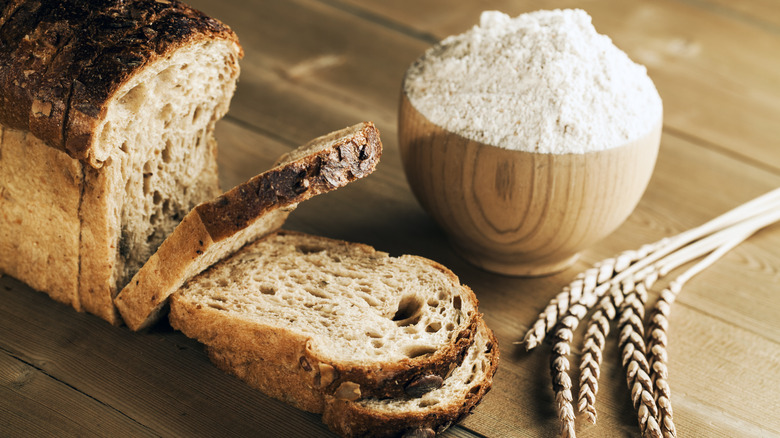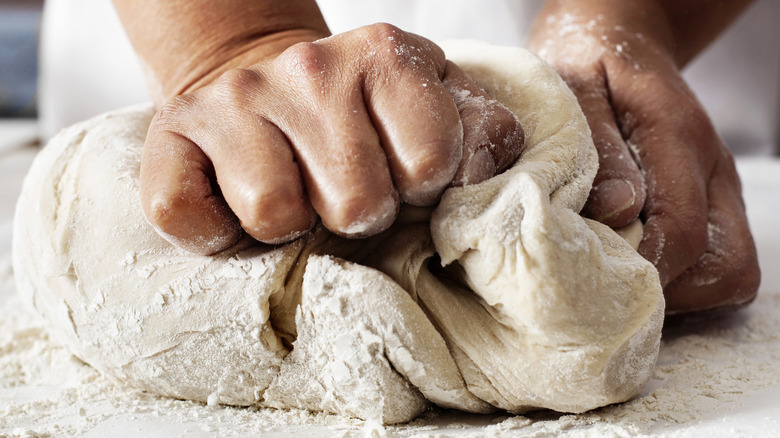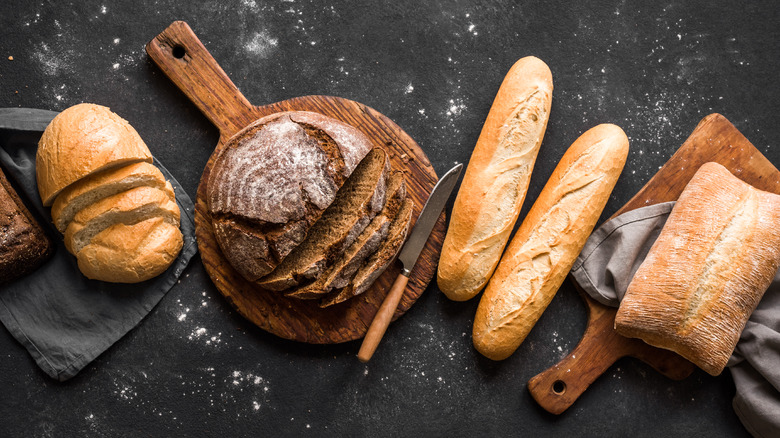How Using Bread Flour Vs All Purpose Flour Changes Baked Goods
If you see bread flour listed on a baking recipe, you might wonder if you can swap it easily with all-purpose flour. Before substituting one flour for the other, though, it's worthwhile to note some key differences between the two ingredients. Due to its higher protein content, bread flour is considered a stronger flour compared to all-purpose flour — resulting in the chewy texture of bagels, stretchy elasticity of pizza dough, and open crumb structure of a hearty ciabatta loaf.
Because of its relative strength, bread flour is meant for baked goods that rely on yeast or a starter culture to rise (as opposed to chemical leavening agents like baking powder). In these bakes, bread flour's higher protein content helps develop strands of gluten networks during kneading and fermentation. The gluten provides structure and leavening by maintaining airy pockets in the bread while it's baking.
This level of strength and gluten development associated with bread flour, on the other hand, is not so great for other bakes like cakes. That's where all-purpose flour comes in. All-purpose flour was designed specifically to be a reliable flour for a range of baking applications, from pastries to dinner rolls. It contains less protein than bread flour, so it will result in more delicate, tender bakes that don't need a lot of gluten development — like fluffy pancakes or birthday cakes.
The strength of the flour is the key difference
The strength of different types of flour may sound like a sort of obscure concept until you consider their wheat sources. Bread flour has a relatively high protein level of about 12 to 14%, since it's composed of hard wheat. On the other end of the spectrum lies pastry and cake flours, which are made entirely of more delicate soft wheat varieties and can contain around 8% protein. All-purpose flour, developed to be the jack of all baking trades, has a protein content right down the middle (ranging from 10 to 12%) since it's a combination of hard and soft wheat.
Even though there's a small difference in protein count it makes all the difference in the strength of the dough. Bread made with all-purpose flour will lack the same quality of chew and structured rise compared to one made with bread flour. Alternatively, subbing bread flour in to make cookies will make them more chewy. It's wise to keep a bag of bread flour on hand for making bread (from rye to sourdough), of course. But, you can also use bread flour for other yeast-risen bakes like sticky buns.
How to use each flour depends the desired result
While bread flour should be your go-to when making any type of bread or yeasted baked good, there is an exception. If you're making quick bread, which typically contains chemical leaveners, all-purpose flour will do. Quick bread doesn't need a big rise as it generally consists of a moister and denser texture than its yeasted cousin.
Technically, you can use all-purpose flour to make yeast bread — we won't judge — but with its mix of soft and hard wheat, it won't absorb the water in the recipe as readily, so you might notice your dough is more sticky. Chances are it will still turn out fine, but it will likely have less rise and less of an open, airy crumb. Bread made with all-purpose flour may come out of the oven a bit tackier or gummy in texture, due to less water having been absorbed, compared to bread flour.
In most cases, you want to avoid using higher protein flour like bread flour to make cakes and other delicate bakes. However, some bakers like to sub in bread flour to make chewy cookies — and it can even give your brownies an extra fudgy bite. Either way, it's worth keeping each type of flour in the pantry, so you can be ready when any baking inspiration strikes.


